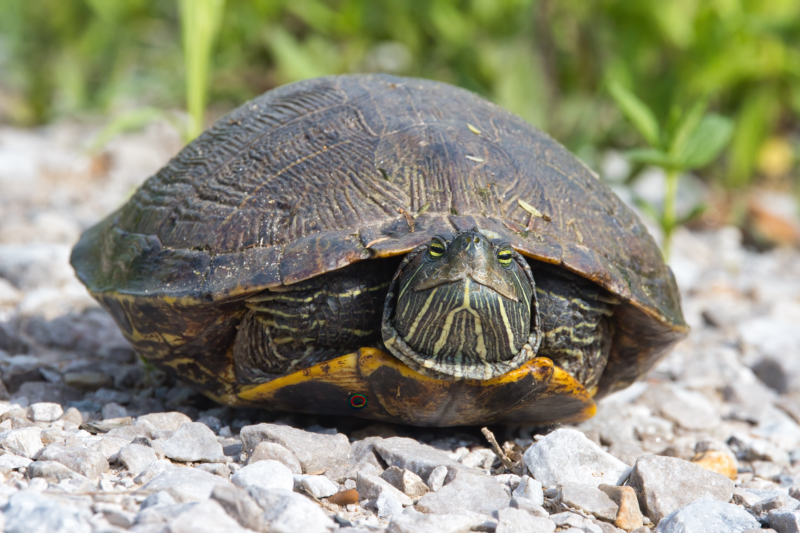This photograph features an Eastern River Cooter, a freshwater turtle species found throughout the southeastern United States. Its defining characteristics include a domed shell with intricate patterns and yellow striping on its head and neck. These turtles are commonly seen basking on logs or rocks near rivers and wetlands. The subject here was photographed on gravel at the Sequoyah National Wildlife Refuge in Oklahoma.

Location and Context
The photo was taken on May 13, 2022, at 9:25 a.m. along the auto tour road at the Sequoyah National Wildlife Refuge. This refuge, spanning over 20,000 acres, provides essential habitats for many species, including turtles, birds, and deer. The gravel road in the image serves as both a path for visitors and a natural crossing point for wildlife. Observing an Eastern River Cooter here reflects the refuge’s ability to support diverse life forms in a protected environment.
Technical Details
- Camera: Canon EOS R5
- Lens: RF100-500mm F4.5-7.1 L IS USM
- Aperture: f/9
- Shutter Speed: 1/2000
- ISO: 1600 (Auto)
- Focal Length: 500mm
- Exposure Compensation: 0
The use of a 500mm focal length allowed a detailed and close-up perspective of the turtle without disturbing it. An aperture of f/9 provided enough depth of field to keep the entire subject sharp while softly blurring the background. The fast shutter speed of 1/2000 effectively captured the moment without motion blur, important for wildlife photography. Shooting at ISO 1600 ensured a properly exposed image under natural light conditions.
Behavioral and Environmental Notes
Eastern River Cooters are primarily herbivores, feeding on aquatic vegetation, though they may eat small animals on occasion. Their behavior often involves basking in the sun to regulate body temperature or migrating short distances to nest. In this photo, the turtle appears to be resting on the gravel, possibly in transit between its aquatic habitat and a nesting site. This seasonal movement is typical in late spring and early summer, when females lay eggs.
The gravel road in this image symbolizes how natural and human-made elements intersect in wildlife refuges. Roads like this often serve as vital pathways for species like turtles but can also pose dangers from vehicles. Images like this remind us of the need for awareness and care in these shared spaces.
Significance of the Photograph
This photograph exemplifies the delicate balance between technical precision and ecological awareness. It highlights the Eastern River Cooter in a natural yet human-adjacent setting, showcasing its role within a larger ecosystem. Wildlife refuges like Sequoyah play a key role in conserving species and their habitats, offering safe spaces for interactions between humans and animals. Through photography, moments like this inspire appreciation and encourage action toward protecting these environments.
This expanded context provides deeper insight into the turtle’s habitat, behavior, and the value of wildlife photography in conservation.
